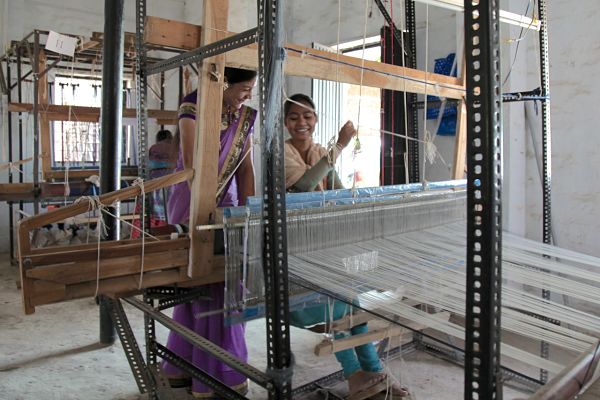



first, hanks of yarn are dyed in the village in small batches. the yarn is then warped, or formed into lines, typically over a barrel,
as they'll be set up for the actual fabric.

it is then typically brought out into the street by 3 or 4 people where it is "sized." the yarns are stretched sometimes a city block where a starch is applied to the yarns to prep it for weaving.

the starch is made with rice or potato starch and natural oils and is painted onto the yarn where it then dries in the sun.
it washes off eventually, but helps make the yarn easily weavable and protect it during the weaving process.


these "warp" yarns are then dressed and aligned, meaning every single yarn in a length of fabric is lined up and
placed by hand-- hundreds of threads-- so it is ready for yarns to be woven in.


the hand loom itself is a contraption of wooden beams, ropes, weighted sacks and pulleys. once the warp is placed on thewooden loom, the act of weaving begins. a wooden shuttle acts like a needle to weave in yarns throughout-- the weft--creating the fabric. each thread is pushed through by hand via the shuttle. each one.


this is where design comes into play-- creating ikats by intricately placed yarns that have been tied and dyed, creating texture using different yarn thickness (our hand loomed box weave used on the eze caftan is made in this way), using several shuttles for different designs on the borders. it gets quite complex. jamdani, a technique we are using in our next collection, involves small motifs throughout the material. each motif is woven into the loom by hand at precise intervals. this takes huge skill and requires a lot of time and patience.


the fabric isn't perfect. you'll see little specs that get woven into the fabric. the looms aren't in a sterile factory-- they're in open air workshop. things in the air get woven in. i love this.
once the yarn comes to end, it must be tied to another length of yarn. each and every yarn-- thousands in a piece of fabric. the weaver's fingers have a mind of their own as they tie tiny knots one after another with such speed, i didn't believe they were tying knots. it looks like they are playing guitar on the yarns. incredible.
the result is a richness that you can't replicate with a machine.
it's soft. the human handling in the process helps make give it the softest hand.
yet it's durable. yarns are stretched the way they are on a machine, so they aren't as "tired" when they are stitched into clothing.

THREE


FOUR
it only gets better.
wash it, wear it, throw it in your bag, jump in a pool wearing it, dry it on the porch... it keeps getting softer and draper. we prewash our handloomed fabric with natural enzymes to make them super soft once they are stitched into caftans. but they only get better. still, treat them gently as they are loosely woven, but they will stand the test of time.


FIVE
it keeps you cool in hot weather and warm in cold weather. the yarns are woven somewhat more loosely, making it possible for air to filter in and out. this creates the unique air like quality and breathability.
there's s reason it's been around for thousands of years. the qualities are really unique and special for a fabric.
handloomed fabric is a huge part of MIRTH. we encourage you to try it, understand it and love it like we do.

















